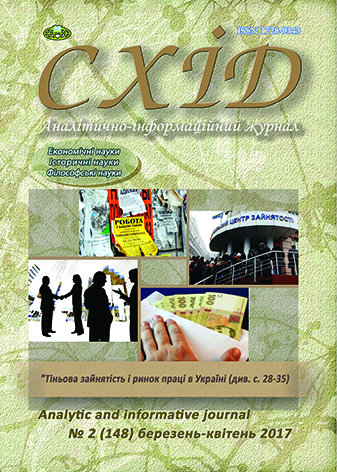Еxploration of the cultural borderland: вorder, boundary, frontier studies
DOI:
https://doi.org/10.21847/1728-9343.2017.2(148).102808Keywords:
boundary, вorder, frontier, the borderline, borderland, intercultural relationsAbstract
The article is devoted to the study of the borderland as a social and cultural phenomenon. The concept of borderline space can be realized in recruitment and solution of boundary and place. It is necessary to consider that the вorderlands may be considered as geographically and procedurally.
It is outlines the history of the formation of the concepts of borderand and frontier. A boundary can be called the limited space, the time, the line of separation of a territory. The border is a line that divides the earth or water of the neighbouring states. Frontier has its own characteristics compared with the border and the boundary. It is the territory of the movable boundary and it is characterized by specificity and complexity of intercultural interactions. The main features of the frontier are uncertainty and instability. He has a higher mobility than cultural heartland, creates new forms of cultural contacts, based on the values of individualism, freedom, respect for the individual, entrepreneurship.
In an English-speaking environment there are some notions, that denote a limit, therefore, there are studies of different kinds of boundaries: вoundary studies, вorder studies, frontier studies. Conceptualization of the phenomenon of the borderland was analyzed, it was defined socio-cultural specifics and dynamics. The broadsemantics of the borderland contains inter-ethnic boundaries, the existence of small cultural groups, search of religious symbios is at interfaith space and linguistic diversity of the border of language forms. Its meaning may reflect the colonial character, the unrealizability and the incompleteness of the certain area surrounded by the dominant forces, but it can discover the potential of cultural interaction.
It presents a socio-philosophical analysis of domestic and foreign research of the classification of the borderland. As the base of the typology it used classification based on the nature of intercultural communicative processes of borderareas. It is established that borderland is a region with social, cultural, economic, political specifics. It was found that the poly-variance frontier depends on the nature of the border. There is a significant integrating potential of the borderland as a territory of intercultural interaction.
Downloads
References
Brednikova, О. (1999), The border and the structuring of a new social space (the case of Narva-Ivangorod), Wandering the border, St. Petersburg, № 7, рр. 19-25. (rus).
Breska, О. (2007), Introduction to border theory, Crossroads Digest, Vilnius, № 1-2, рр. 156-174. (rus).
Babkou, I. (2005), Ethics of the Borderland: Transculturalism as Belarusian Experience, Crossroads Digest, Vilnius, № 3-4, рр. 127-136. (rus).
Donets, P. (2011), On the «border» discourse, Cognition, communication, discourse, Kharkov, № 3, рр. 16-25. (rus).
Kochan, V. (2008), The phenomenon of Borderlands in sociocultural dimension: author. dis... kand. of philosophical Sciences, Simferopol, 21 p. (ukr).
Lychkovakh, V. (2006), Transgression and artistic creativity, Miracle garden of culture: Selected papers on aesthetics, cultural studies, philosophy of art, Chernihiv, рр. 27-38. (ukr).
Boundary (1973), Dictionary of the Ukrainian language: Ukrainian Academy of sciences. Institute of linguistics, Vol. 4, Naukova Dumka, Kуiv, р. 666. (ukr).
Romanova, A. (2015), The specifics of intercultural communication at frontline territories, The Caspian region: politics, economy, culture, № 3 (44). рр. 266-271. (rus).
Starodubtseva, L. (2008), The irony of bilingualism, or life on the borders of languages, COLLEGIUM, № 22, рр. 48-57. (rus).
Haritonovich, S. (2007), Collision of identities in the border zone: postcolonial syndrome, Crossroads Digest, Vilnius, № 1-2, рр. 143-155. (rus).
Chornovol, I. The concept of frontier in the languages of the peoples of the world, available at: ttps://www. academia.edu/11169304. (ukr).
Chornovol, I. (2015), The theory of comparative frontiers: international and domestic dimension, Кriticа, Kуiv, 376 p. (ukr).
Chornovol, I. (2012), Frontire Of Ancient Rome, Drohobych local history collection, № ХVI, Kolo, Drohobych, рр. 18-31. (ukr).
Yakushenkova, O. (2012), Woman on the American frontier, АSU, Astrakhan, 215 p. (rus).
Lamont, M. & Molnar, V. (2002), The Study of Boundaries in the Social Sciences, Annual Review of Sociology, рр. 167-195. DOI: 10.1146/annurev.soc.28.110601.141107.
Rieber, A. (2003), The Comparatіve Ecology of Complex Frontіers, Іmperіal Rule, ed. by A. Mіller and A.Rіeber, Budapest, New York, рр. 177-207. (eng).
Turner, F. J. (1994), The Significance of the Frontier in American History, New York, рр. 31-33. (eng).
Whittaker, C. R. (1997), Frontiers of theRoman Empire: A Social and Economic Study, Johns Hopkins University Press, 360 р. (eng).
Wolfreys, J. (2008), Transgression: Identity, Space, Time. Palgrave Macmillan. DOI: 10.1007/978-1-137-02127-4
Downloads
Published
How to Cite
Issue
Section
License
Copyright (c) 2017 Maryna Kolinko

This work is licensed under a Creative Commons Attribution-NonCommercial-NoDerivatives 4.0 International License.
1. Authors bear responsibility for the accuracy of facts, quotations, numbers and names used.
2. Manuscripts are not sent back.
3. The publisher does not always agree with the authors' opinion.
4. The authors reserve the right to authorship of the work and pass the first publication right of this work to the journal under the terms of a Creative Commons Attribution-NonCommercial-NoDerivatives 4.0 International License. This license allows others to distribute (copy) the published work for non-commercial purposes, provided there is mandatory attribution to its authors and a link to the first publication in our journal.
5. The authors have the right to conclude separate supplement agreements that relate to non-exclusive work distribution in the form in which it has been published by the journal (for example, to upload the work to the online storage of the journal or publish it as part of a monograph), provided that the reference to the first publication of the work in this journal is included.

